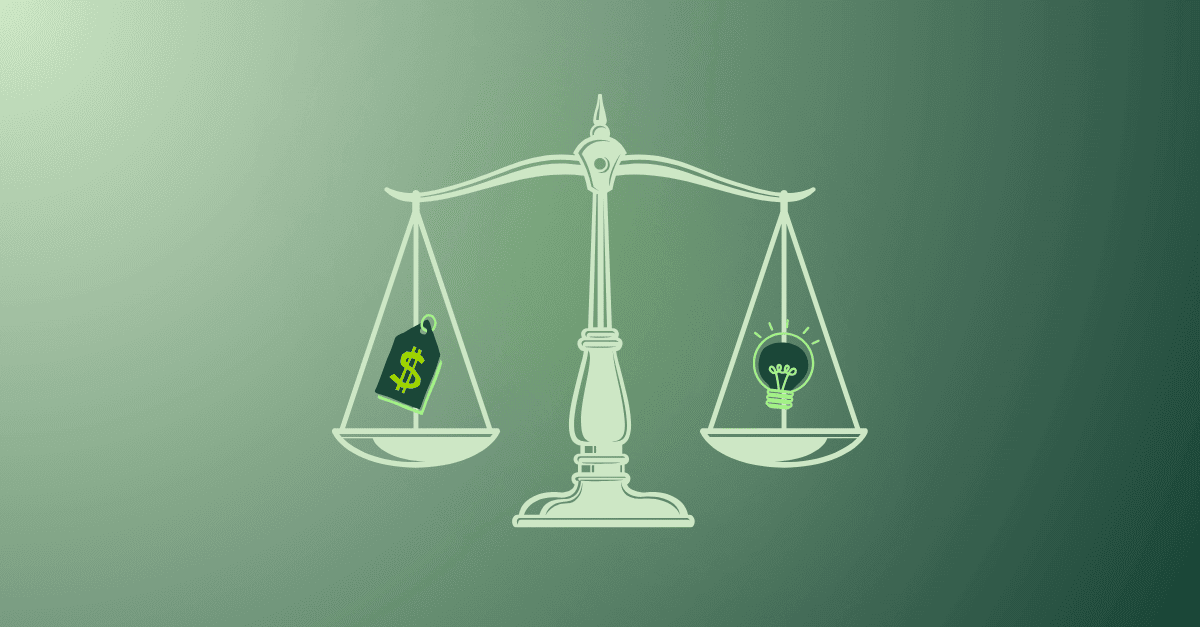SaaS vendors are diversifying their pricing structures in an effort to make user adoption easier—now, over 60% of SaaS companies are choosing usage-based pricing or hybrid models over just subscription models.
Whether you choose a usage-based model or a subscription-based model, it’s essential to understand that both are considered recurring revenue models—in essence, reliable revenue streams that are highly likely to keep generating returns into the future. A subscription-based pricing model, however, is generally more straightforward as the billing amount is usually the same over each period.
Meanwhile, usage-based models lead to dynamic income as they tend to operate via a pay-as-you-go pricing structure in which customers are only billed for the exact amount of services they use. Fortunately, there’s no need to choose between the two—hybrid plans that combine subscriptions with further usage fees are also gaining traction as viable SaaS billing strategies. For example, Zapier offers subscription tiers with additional usage fees based on the number of tasks you need per month.

Nevertheless, comparing usage-based pricing vs subscription pricing pros and cons can be advantageous in deciding whether one or both can best support customer retention and revenue growth for your company. Let’s examine both so you can which is best for you.
What Is Usage-Based Pricing?
Usage-based pricing models allow customers to pay solely for what they use. SaaS companies calculate what their clients owe for a billing period using a predetermined metric—such as number of users or bandwidth usage.
Usage-based business models are especially popular among payment processors, who often take a small percentage from the transfers they facilitate. Generally speaking, other sectors, such as cloud computing and communication services, likewise utilize usage-based models by charging per user.
Advantages and Challenges of Usage-Based Pricing
Some of the main reasons why SaaS companies are adopting usage-based pricing include:
- Transparency: SaaS companies share a reliable means of tracking usage with their customers. Therefore, no hidden fees or surprise charges come at the end of a billing cycle.
- Higher Net Dollar Retention: According to a 2021 Study by Bessemer Venture Partners, companies that utilize usage-based pricing average roughly ten percentage points higher in net dollar retention than companies that use a more traditional subscription-based model.
- Scalability: Companies can easily scale their usage up to meet their organizational needs after determining that a SaaS solution works. Similarly, if demand is low or a platform isn’t a viable fit, they can simply reduce their usage without paying for shelfware or underutilized applications.
But usage-based models aren’t always a no-brainer. For some companies, they may not be the right choice due to their:
- Variability in Income and Forecasting: From a SaaS vendor’s perspective, usage-based pricing means uncertain income and a less reliable recurring revenue source, as clients can slow or discontinue usage at the drop of a hat.
- Billing complexity: Usage-based pricing models often involve complex billing rules and calculations based on factors such as volume discounts, peak/off-peak usage, or other variables. Implementing and maintaining these rules within billing systems requires careful attention to detail and thorough testing to ensure accuracy.
- Volatility: Usage-based pricing generally operates on a Number of Units Used x Price Per Unit = Amount Paid formula. If a company’s usage needs suddenly increase or their vendor raises their unit costs, they could see a major price hike during their next billing cycle.
What Is the Subscription Business Model?
Subscription models charge users flat fees for access to a set amount of services over a certain period. This access is generally billed through fixed recurring payments. For example, a SaaS vendor may charge companies $1,000 monthly for up to 200 users to utilize its platform.
Generally, subscription-based pricing is contracted over a fixed term.
Streaming services like Netflix are a prime example of subscription-based models, as they charge for a set plan over a fixed period. Electronic publications, educational technology services, and eCommerce memberships such as Amazon Prime are great examples of subscription-based models.
Pros and Cons of Subscription Models
Subscription-based pricing is a tested and true model dating back a century to the days of magazines and milkmen. It’s withstood the test of time due to its:
- Predictability: With subscriptions, the vendor and client know exactly how much they’ll earn or spend each billing period. That makes it easy for SaaS companies to forecast revenue and for their clients to plan their expenses.
- Guaranteed customer retention: SaaS customers generally sign extended contracts to gain access to subscription-based services. This guarantees income throughout the billing period and gives time for the software to work its way into the client’s infrastructure and become essential to their workflow. This, in turn, can cause companies to stay with their SaaS providers due to the ease and familiarity rather than shop around for competing products.
Despite these upsides, there are a few reasons some companies are wary of subscription-based models, including:
- The potential to purchase shelfware: With a subscription-based model, you’ll pay to access a SaaS platform whether it gets used.
- The need for constant value addition: When it comes time for renewal, SaaS companies must make a case for their clients to stick with their products. Thus, subscription-based platforms need constant upgrades and add-ons to pull in customers.
Comparing Usage-Based Pricing vs Subscription
Picking between these two competing pricing models can be a difficult choice—which is likely why many SaaS companies opt for hybrid structures. Nonetheless, you can make an informed choice by understanding how they differ in the following:
- Billing: Billing is more complex with usage models as vendors need to calculate their clients’ consumption and factor it against their pricing. Alternatively, subscriptions offer the comparatively easy route of charging the same flat fee every cycle.
- Customer engagement: Generally, clients using subscription services have a better grasp of the value they provide. On the other hand, monitoring usage and paying different sums every period forces organizations to continually weigh the benefits of a platform versus its cost.
- Revenue predictability: Subscription-based models make it easier for companies to forecast revenue since they can reliably know when and how much money is coming in. This, in turn, leads to greater organizational stability and a more predictable, steady cash flow.
Choosing between subscription and usage-based models depends on your business type, customer base, and offerings. Usage is a more viable choice for companies that:
- Incur direct costs when their customers use services, such as data storage platforms that need to purchase more server space as their client network expands
- Can break down their service into easily identifiable metrics, such as user headcount or percentages for processed payments
- Can bear cyclical revenue fluctuations without going belly up
Alternatively, you may find subscription-based models a better fit for your business if you:
- Need a consistent, predictable amount of revenue to stay in operation
- Don’t have a way to easily identify a value metric that you can base your unit pricing on
Implementing Your Chosen Pricing Model With RightRev
RightRev can help your company track, recognize, and report revenue regardless of your chosen pricing model. If you opt for subscriptions, we can quickly help you manage the persistent upgrades and downgrades that change forecasted revenue between billing cycles.
And, if your product is lumped in with bundle deals or hardware packages, you can quickly account for those with customizable revenue recognition rules suited to your needs.
Manual reporting can be complicated if you choose a usage-based model, as revenue figures change every cycle, and latent revenue from sign-ups might not be realized for several months. Fortunately, RightRev’s intelligent recognition technology can quickly determine your revenue and assign it to the correct period.
Take learning management pioneer Docebo as an example. Due to significant growth and global expansion, they needed help managing the wealth of revenue from their operations.
With RightRev, they could centralize reporting within the Salesforce Revenue Cloud, standardize their recognition process, and automate many manual tasks that slowed their workflow. Docebo is just one shining example of how companies succeed with RightRev—and you, too, can optimize your revenue with RightRev’s solutions.
Check out our blog for more insights on revenue optimization strategies, and request a demo to learn how RightRev can simplify your recognition and reporting procedures.




